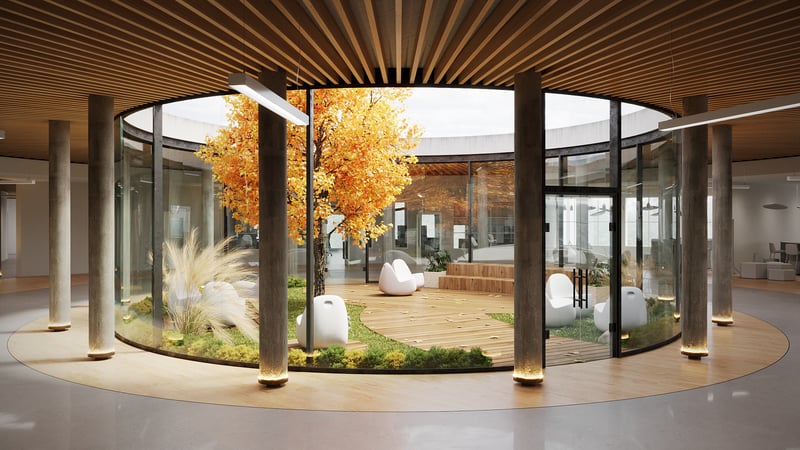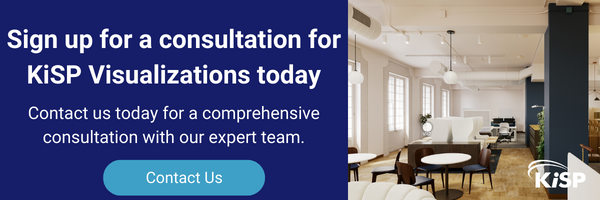New design considerations are trending among office designers (and our clients!) all the time. Over the last few years, we have heard about hybrid work design, hoteling, and ancillary trends, among others. In 2024 one of the new top trends is the concept of biophilic design. This trend builds on the already existing design elements of natural materials and sustainability but dives into a more natural way of incorporating it into professional spaces such as offices, healthcare spaces and educational spaces.
As you work to become partners with your clients and bring them the latest in design trends that attract new talent and make workers more productive, join us as we dive into biophilic office design and look at the role it is playing today. And, don’t forget to present your solutions in a tool that lets them see your proposal and all of its options – The KITS collaborator.
The Concept of Biophilic Office Design
Biophilic office design is an approach that incorporates elements of nature into the design and layout of office spaces. It aims to create a connection between employees and the natural environment, promoting a sense of well-being and productivity.
The concept is based on the idea that humans have an innate affinity for nature, and by incorporating natural elements such as plants, natural light, and water features, office spaces can provide a more stimulating and calming environment.
Biophilic office design also includes the use of natural materials, such as wood and stone, to create a more organic and soothing atmosphere. It encourages the integration of nature into the workplace, whether through indoor plants, living walls, or outdoor green spaces.
Benefits of Biophilic Office Design for Employee Wellness
Biophilic design goes beyond aesthetics. Research demonstrates its positive impact on health, productivity, and creativity. Studies have found that incorporating natural elements into the workplace can reduce stress levels, improve mood, and increase overall well-being.
By providing access to natural light and views of nature, biophilic office design can help regulate circadian rhythms and improve sleep patterns. This can lead to increased alertness and productivity during the day.
The use of plants and greenery in the office has also been linked to improved air quality and reduced levels of toxins, creating a healthier and more comfortable work environment. Additionally, biophilic office design has been shown to enhance creativity, focus, and cognitive function.
Overall, by creating a more natural and biophilic workplace, employers can promote employee wellness and create a positive and productive work environment.
Implementing Biophilic Office Design in the Workplace
Implementing biophilic office design in the workplace requires careful planning and consideration. It involves assessing the current office space and identifying areas where natural elements can be incorporated.
One of the key elements of this office design trend is the use of plants and greenery. This can be done by adding potted plants throughout the office, creating living walls, or even incorporating vertical gardens. It is important to choose plants that are suitable for indoor environments and require minimal maintenance.
Another important aspect is the integration of natural light. This can be achieved by maximizing natural light sources, such as windows and skylights, and minimizing the use of artificial lighting. It is also important to provide access to views of nature, whether through windows or by creating outdoor spaces for employees to enjoy. This could be patios, courtyards, atriums, or other building feature that would easily include nature and natural light.

The use of natural materials, such as wood and stone, can also help create a more biophilic workplace. This can be done through the selection of furniture, flooring, and finishes that mimic natural textures and patterns. Wood is the easiest to incorporate with furniture, but stone can be considered for flooring, counters, and accent walls.
The effort will prove worthwhile and you can assure your clients that this design style should stand the test of time. Biophilic design reflects elements found in timeless architectural styles. From the incorporation of courtyards in ancient Roman villas to Japanese Zen gardens, the core principles have been around for centuries, suggesting lasting appeal. The natural materials and colors should prove less ‘dated’ than other design trends, not only because of the ties to the natural environment but the growing understanding that most people have a natural attachment to this decor style.
Overall, implementing a biophilic office design requires a rounded approach that considers the needs and preferences of employees, as well as the constraints of the existing office space.
Examples of Successful Biophilic Office Designs
There have been several successful examples of biophilic office designs that have had a positive impact on employee wellness and productivity.
One example is the Amazon Spheres in Seattle, which features a unique combination of natural elements and innovative design. The three interconnected glass domes house over 40,000 plants from around the world, creating a lush and vibrant workspace for employees.
Another example is the Etsy Headquarters in Brooklyn, which incorporates biophilic design principles throughout the office space. The office features a living wall, rooftop gardens, and ample natural light, creating a calming and inspiring environment for employees.
These examples demonstrate the potential of biophilic office design to create innovative and sustainable workspaces that prioritize employee well-being.
The Future of Biophilic Office Design
The future of biophilic office design looks promising, as more companies recognize the benefits of incorporating nature into the workplace.
Advancements in design have made it easier to implement biophilic elements, such as living walls and smart lighting systems, in office spaces. There is also a growing body of research that supports the positive impact of biophilic design on employee well-being and performance.
In the future, we can expect to see more innovative and sustainable biophilic office designs that prioritize employee wellness and environmental sustainability. This includes the use of renewable materials, energy-efficient systems, and the integration of nature into urban environments.
As the importance of employee wellness and sustainability continues to grow, biophilic office design will play a crucial role in creating healthy and inspiring workspaces for the future.
With KiSP visualization services and space planning services, we can help you visualize your sustainable spaces clearly and effectively. Check out more about our visualization services and our space planning services. Or learn about more office design trends that you can incorporate into your office spaces.



